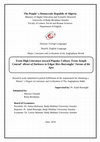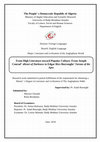Papers by Marwa Roumar

This dissertation discusses the intertextual relationship that exists between Heart of Darkness (... more This dissertation discusses the intertextual relationship that exists between Heart of Darkness (1899) and Tarzan of the Apes (1912), through a comparative study. In terms of a range of critical theories, it sheds light on the similarities and differences that exist between the two pieces of writing. Thus, Edgar Rice Burroughs’s novel is seen as an explanation for the ambiguity that exists in Conrad’s novella. The point here is not just to show how the latter echoes Conrad’s novella, but the way that these pieces of arts intervene within each other, because even with the binary that exists between the two in terms of high and low culture, they still transmit the same message by narrating two stories that follow the same events. Hence, the main focus is to draw the similarities and differences between the two texts and to explain how both novels tackle the issue of imperialism and racism. The two novels are examined and made to interact with each other in terms of dialogical and intertextual principles. In other words, they ‘dialogise’ with each other by adopting the same discourse, through which both authors show the way they see the other world ‘Africa’. This relationship between the two novels is examined from a number of perspectives: comparative, intertextual and postcolonial theory.
Thesis Chapters by Marwa Roumar

This dissertation discusses the intertextual relationship that exists between Heart of Darkness (... more This dissertation discusses the intertextual relationship that exists between Heart of Darkness (1899) and Tarzan of the Apes (1912), through a comparative study. In terms of a range of critical theories, it sheds light on the similarities and differences that exist between the two pieces of writing. Thus, Edgar Rice Burroughs’s novel is seen as an explanation for the ambiguity that exists in Conrad’s novella. The point here is not just to show how the latter echoes Conrad’s novella, but the way that these pieces of arts intervene within each other, because even with the binary that exists between the two in terms of high and low culture, they still transmit the same message by narrating two stories that follow the same events. Hence, the main focus is to draw the similarities and differences between the two texts and to explain how both novels tackle the issue of imperialism and racism. The two novels are examined and made to interact with each other in terms of dialogical and intertextual principles. In other words, they ‘dialogise’ with each other by adopting the same discourse, through which both authors show the way they see the other world ‘Africa’. This relationship between the two novels is examined from a number of perspectives: comparative, intertextual and postcolonial theory.











Uploads
Papers by Marwa Roumar
Thesis Chapters by Marwa Roumar